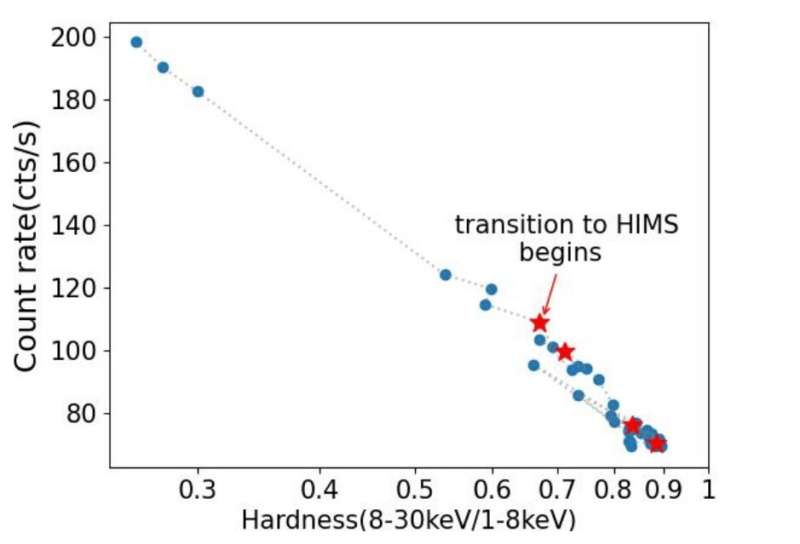July 4, 2023 report
This article has been reviewed according to Science X's editorial process and policies. Editors have highlighted the following attributes while ensuring the content's credibility:
fact-checked
preprint
trusted source
proofread
Quasi-periodic oscillations detected in X-ray binary GX 339−4

Chinese astronomers have used the Hard X-ray Modulation Telescope (HXMT) to observe the latest outburst of a low-mass X-ray binary system known as GX 339-4. They detected new quasi-periodic oscillations in this source. Their findings have been published on the pre-print server arXiv.
X-ray binaries (XRBs) consist of a normal star or a white dwarf transferring mass onto a compact neutron star or a black hole. Based on the mass of the companion star, astronomers divide them into low-mass X-ray binaries (LMXB) and high-mass X-ray binaries (HMXB).
Located some 39,000 light years away from the Earth, GX 339-4 is a recurrent black hole LMXB first detected in 1973. Its black hole is estimated to be at least 5.8 times as massive as the sun. GX 339−4 has undergone frequent outbursts, experienced quasi-periodic oscillations (QPOs) and displayed all the black hole accretion states during the last thirty years.
All in all, GX 339-4 has been comprehensively investigated at all wavelengths, making it one of the most studied black hole LMXBs.
The latest outburst of GX 339-4 began in early 2021 and a team of astronomers led by Wei Wang of the Wuhan University in China, decided to perform HXMT observations of this event in order to shed more light on the behavior of this system. This resulted in the detection of new quasi-periodic oscillations (QPOs).
In general, QPOs are believed to occur when X-rays are emitted near the inner edge of an accretion disk in which gas swirls onto a compact object like a neutron star or a black hole. QPOs in black hole X-ray binary systems are classified into Type-A, -B, or -C, based on properties like the quality factor and the shape of the noise associated with the oscillation.
"By using the data of Insight-HXMT from February to March 2021, we make the X-ray timing analysis of this new outburst. Based on the results of count rates, hardness-intensity diagram (HID) and power density spectrum (PDS), we confirm that the source exhibits spectral transitions from the low-hard state (LHS) to the hard-intermediate state (HIMS). During the transition from the LHS to the HIMS, low-frequency quasi-periodic oscillations (LFQPOs) are detected in the PDS," the researchers explained.
The observations detected type-C QPOs with centroid frequencies evolving from 0.1 to 0.6 Hz in the low-hard state and in the 1−3 Hz frequency range in the hard-intermediate state. The authors of the paper noted that Type-C QPOs are the most common type of QPOs in black hole XRBs, and occur mostly in the low-hard and hard-intermediate states.
Furthermore, Wang's team managed to identify a phase lag behavior (in the 50-100 keV band) in GX 339-4 for the first time. It turned out that when the QPO centroid frequency is below 0.2 Hz, the lag is negative, but becomes positive after that. However, more observations are required in order to understand the physical mechanisms such phase lags.
The study also found that in the root-mean-square (rms) -energy spectrum, the QPO rms first remains flat at lower energy, and then decreases from about 10% below 10 keV to 2% above 50 keV. The researchers added that the same correlation between the rms of QPOs and the photon energy above 10 keV occurred during the 2006/2007 outburst when the QPO frequency was less than 1 Hz.
More information: Y. J. Jin et al, Quasi-periodic oscillations in GX 339-4 during the 2021 Outburst observed with Insight-HXMT, arXiv (2023). DOI: 10.48550/arxiv.2306.13994
Journal information: arXiv
© 2023 Science X Network





















